Fantastic (stock) plugins and how to use them: Logic Pro Compressor
This hugely powerful tool, included with one of the world's most popular DAWs as standard, packs several vintage-modelled, great-sounding compressors into one plugin

Compression is a fundamental cornerstone of music production and sound engineering. Since its development in the 1930s, it’s helped drive the loudness war, significantly enhanced recording production quality, and enabled engineers to shape and manipulate the dynamics of sounds in ways that wouldn’t otherwise be possible.
Because of this, it’s standard practice for DAWs to include compression plugins, and whether you’re a hobbyist or a pro, you’ve more than likely used compression in your music making. Did you know, however, that one DAW includes analogue-modelling of some of the most iconic compressors from the history of sound recording?
Legends of compression
In the days of analogue recording, effects and processing (such as compression) were accomplished with (analogue) hardware; rack-mounted equipment that was patched into the signal-chain (usually via the insert send/return of a mixing-desk).
Some commonly used hardwares (such as the Roland Tape-Echo and the EMT Plate Reverb) would go on to become legendary in their own right; icons of music-production, as they were used on a great many commercial releases. Compressors are no exception and there are a handful of highly regarded, highly coveted, vintage compressors that many people still utilise today.
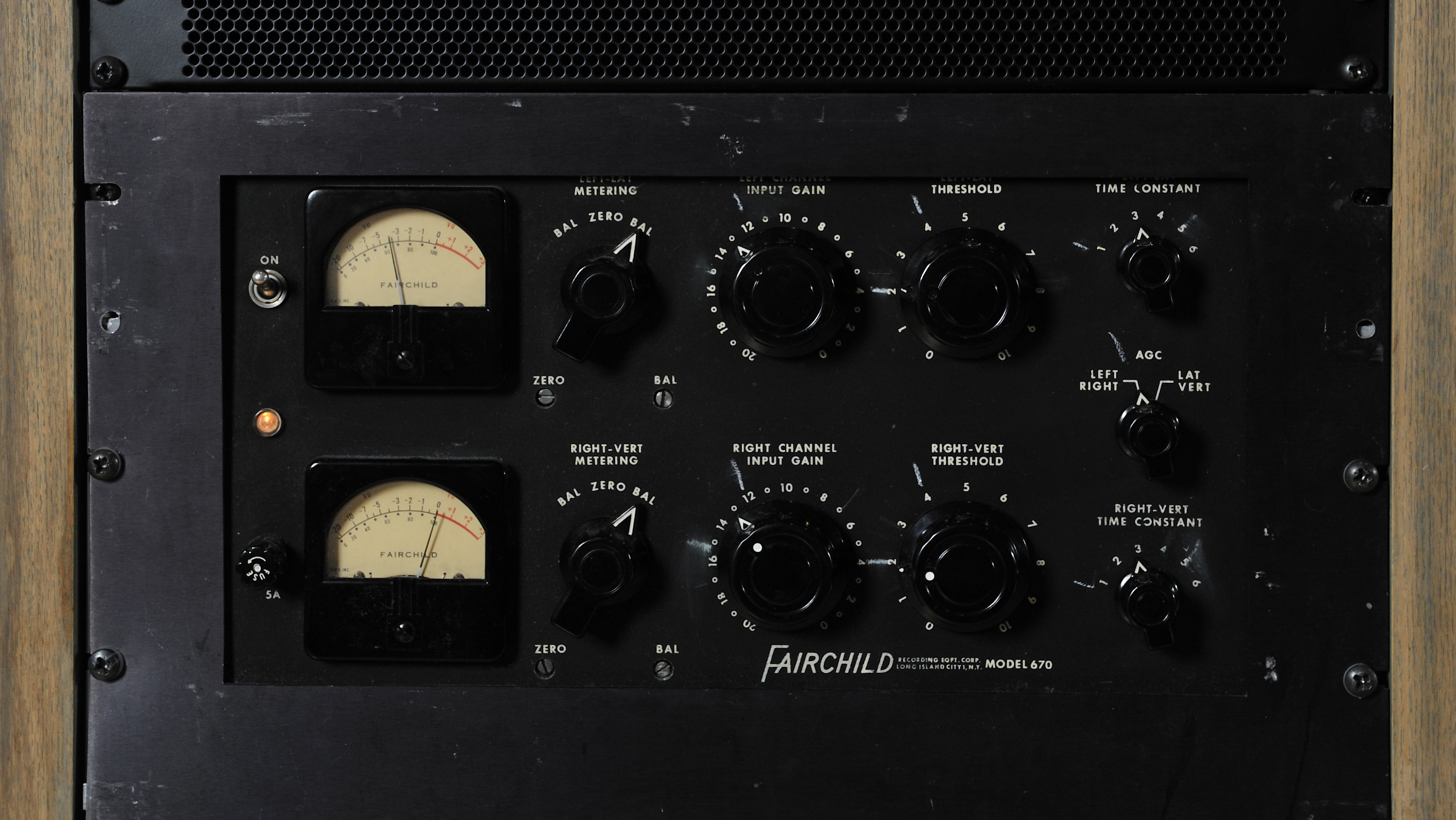
By modern standards however, most of these technological icons are not feasible due to their size, cost, reliability, etc (not to mention rather inconvenient to integrate into mostly digital setups). Thankfully, analogue-modelling software has meant that we’re able to have faithful recreations of these icons in the digital domain of our DAWs. Typically, whilst these plugins are cheaper than their hardware counterparts, they can still command a considerable price tag.
If you’re a Logic Pro user however, you may not realise that you have several vintage-modelled, highly coveted compressors at your disposal, as standard. It’s arguably one of Logic’s coolest, most understated features. In this article we’ll delve into the different compressor models available within Logic Pro, and what differentiates them from one another.
Note: If you’re unfamiliar with compression and/or how it works, I highly recommend our beginners guide to compression, to bring yourself up to speed on some of the terminology.
Want all the hottest music and gear news, reviews, deals, features and more, direct to your inbox? Sign up here.
Logic Pro's Compressor
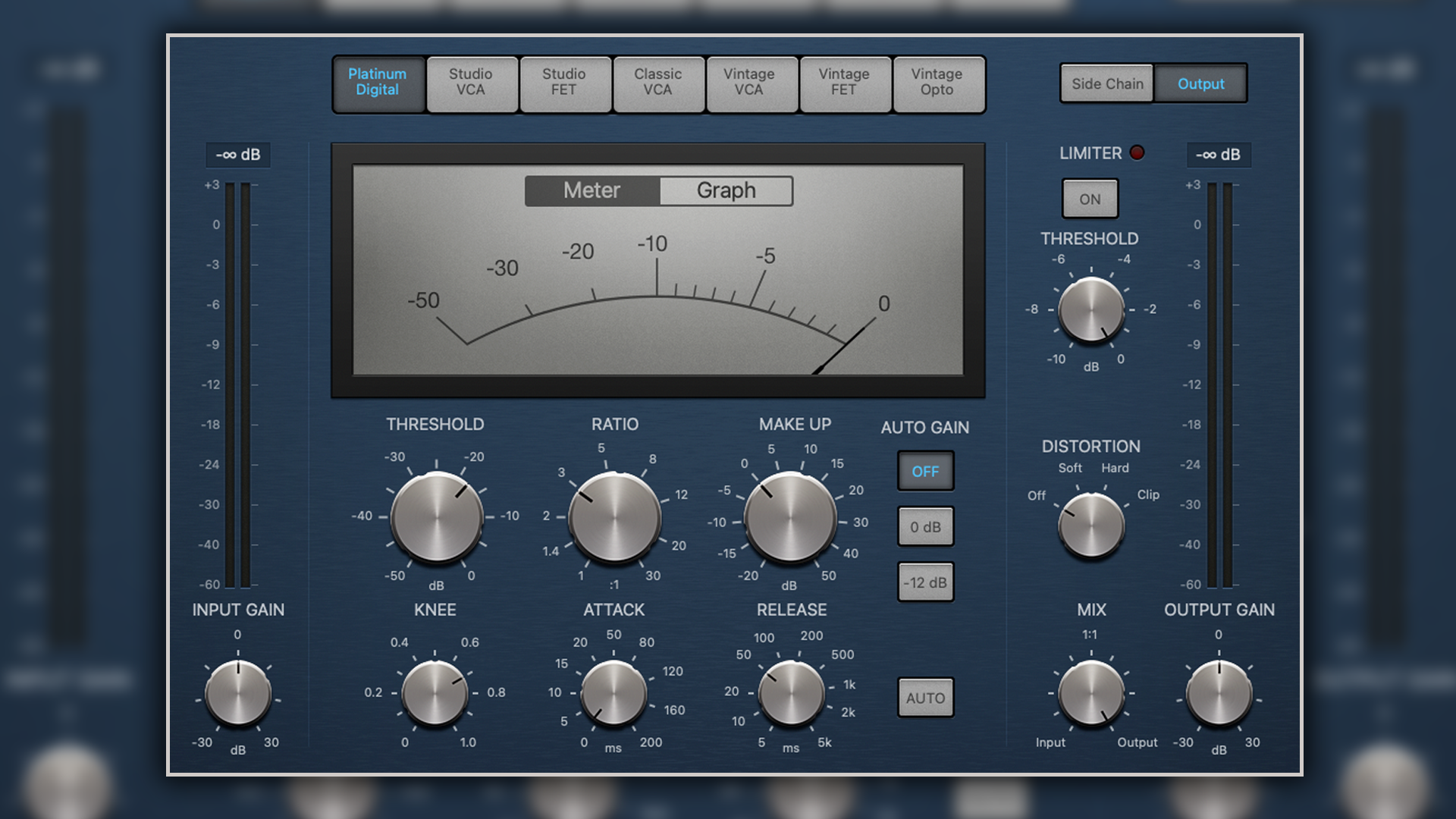
Upon inserting a compressor on a channel-strip, you’ll be presented with the Platinum Digital model. Think of this as the clinical, super-variable option that allows you to highly customise all aspects of the compressor. Arguably something that’s only feasible in a digital application (unlike the above-mentioned analogue compressors).
As a default offering, this is a strong compressor that enables colourless dynamic manipulation and super-precise control, thanks to multiple ways to gain-stage, very broad parameters of attack and release (including an auto-detect option), and a variable knee (as opposed to switching)
I find myself using this model when I simply want clean, subtle compression. I also tend to use this model when I want to design specific side-chain pump characteristics on electronic music.

Somewhat unassumingly, there are some switches along the top of the plugin which change the modelling of the compressor to that of several iconic compressors from the history of music production and sound engineering.
Apple can’t explicitly use the original names (for licensing reasons), but between their code-names, the features, and their visual design, there’s enough detail to glean what’s what, and determine which model corresponds to which vintage compressor. Let’s delve into them!
Studio VCA

With the change in aesthetic to a brushed aluminium, red paint-job and those distinctive knob-designs, it’s no surprise that this model takes its inspiration from the Focusrite Red series of compressors.
Released in the early 1990s, the Focusrite Red series of compressors quickly became a modern go-to for most professional studios. It was an award winning compressor and a popular choice with iconic producers such as Chris Lord-Alge.
What made the Red so versatile, popular and distinctive was its incredibly clean, minimalist signal-path and use of true-peak response (as opposed to RMS). This made it a highly accurate and precise compressor, capable of extremely fine and detailed compression, enhancing its ability to be seemingly invisible; compressing without any discernible pulling or pumping of amplitude, even under heavy compression ratios.
If you’re looking for super-precise compression, capable of smoothness and openness, even under a heavy load, this is certainly one to try.
Studio FET
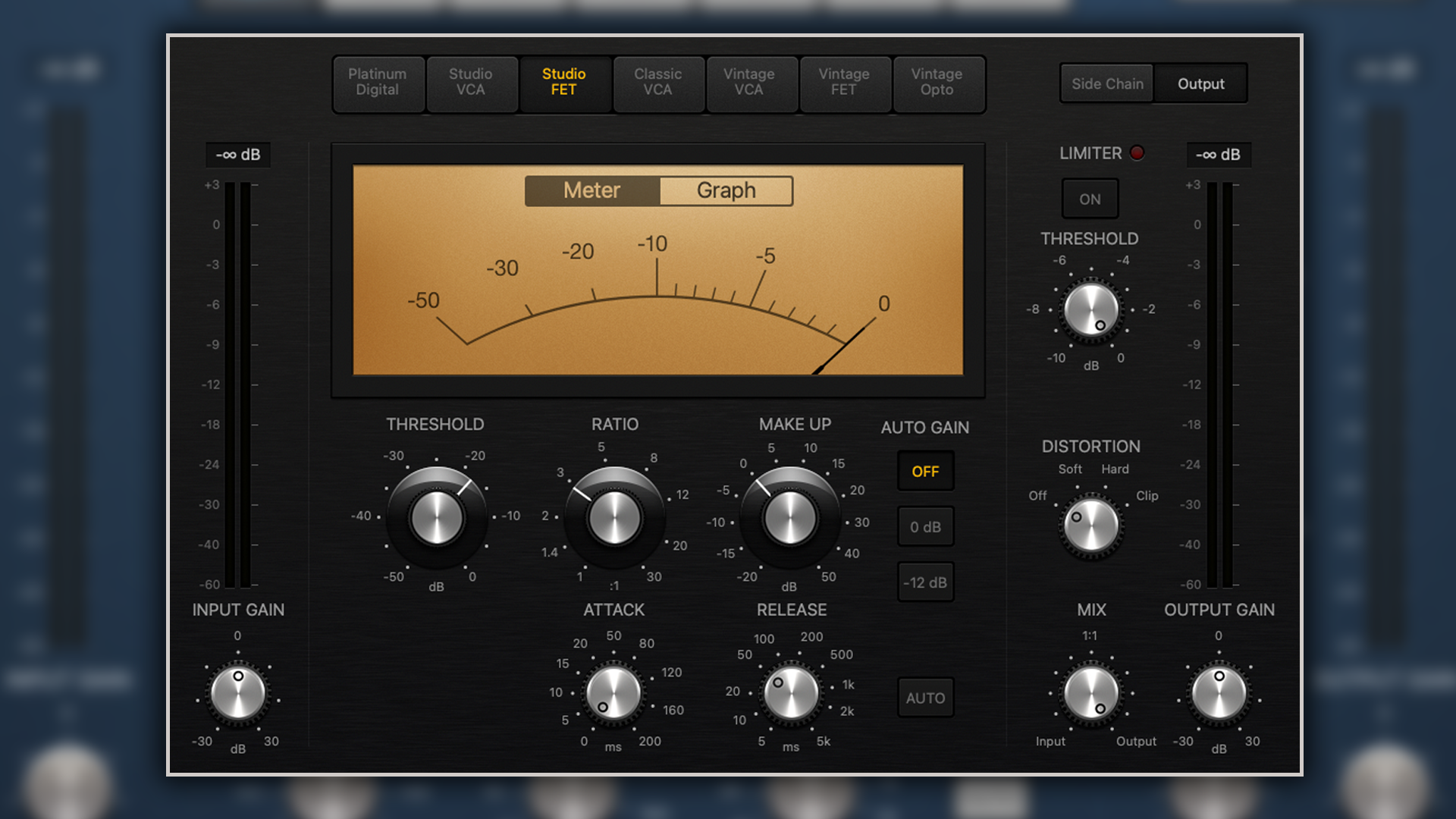
From the highly precise (and relatively modern), to the truly iconic and vintage. The Studio FET is based on the Urei 1176 from the late 1960s (although this particular model is based on the more modern version - more on this below).
The 1176 is a staple of studio recording and has taken several guises over the decades, with several small-scale independent companies building clones of this unit. Nowadays it’s manufactured by Universal Audio.
It was one of the first solid-state compressors (as opposed to vacuum-tube). Upon its release, it also boasted faster attack and release speeds than had previously been available. Furthermore, it offered different ratios of compression, a feature that was new (and pretty revolutionary) at the time.

The original had switchable ratios, but in Logic’s case, it maintains the variable ratio dial, which is a nice modernisation. The knee control has been omitted for this model, as there was none on the original, with its fixed, predetermined knee being an intrinsic aspect of its character.
Whilst its ratio-selectors, attack/release controls and overall dynamic characteristics were very distinctive, it was arguably the tone and warmth of its output transformers that made it such a popular choice, and mainstay in studios throughout the world (to this day).
Regardless of your genre or whatever you’re compressing, this particular model is a great place to start for all-round warmth and character.
Classic VCA
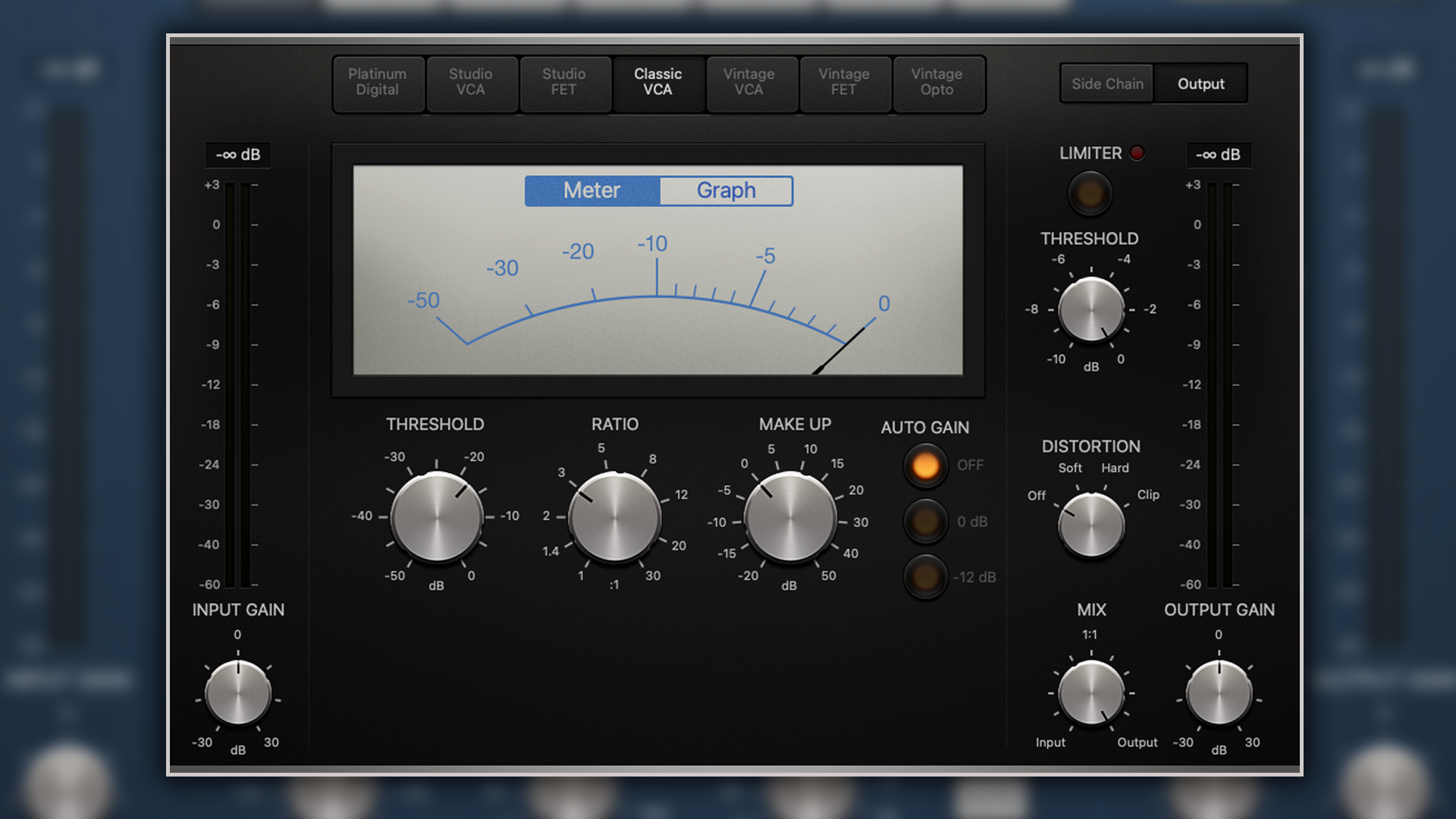
Moving forward a little in time, to the 1970s, the Classic VCA is based on the iconic DBX 160 VU. The 160 VU utilised voltage controlled amplification (VCA) at its core. Its unique layout of heat-matched transistors was a patented design known as the “Blackmer Gain Cell” (named after its inventor David Blackmer), and was the backbone to the 160 VU’s high quality signal processing.
Another key feature of this compressor was its apparent simplicity. It had a fixed ratio and fixed attack/release. Whilst this could be considered crude, or simple, it was in part an effort to be commercially competitive, offering a professional grade compressor that was more affordable than an 1176 or LA-2A (more on the LA-2A below).
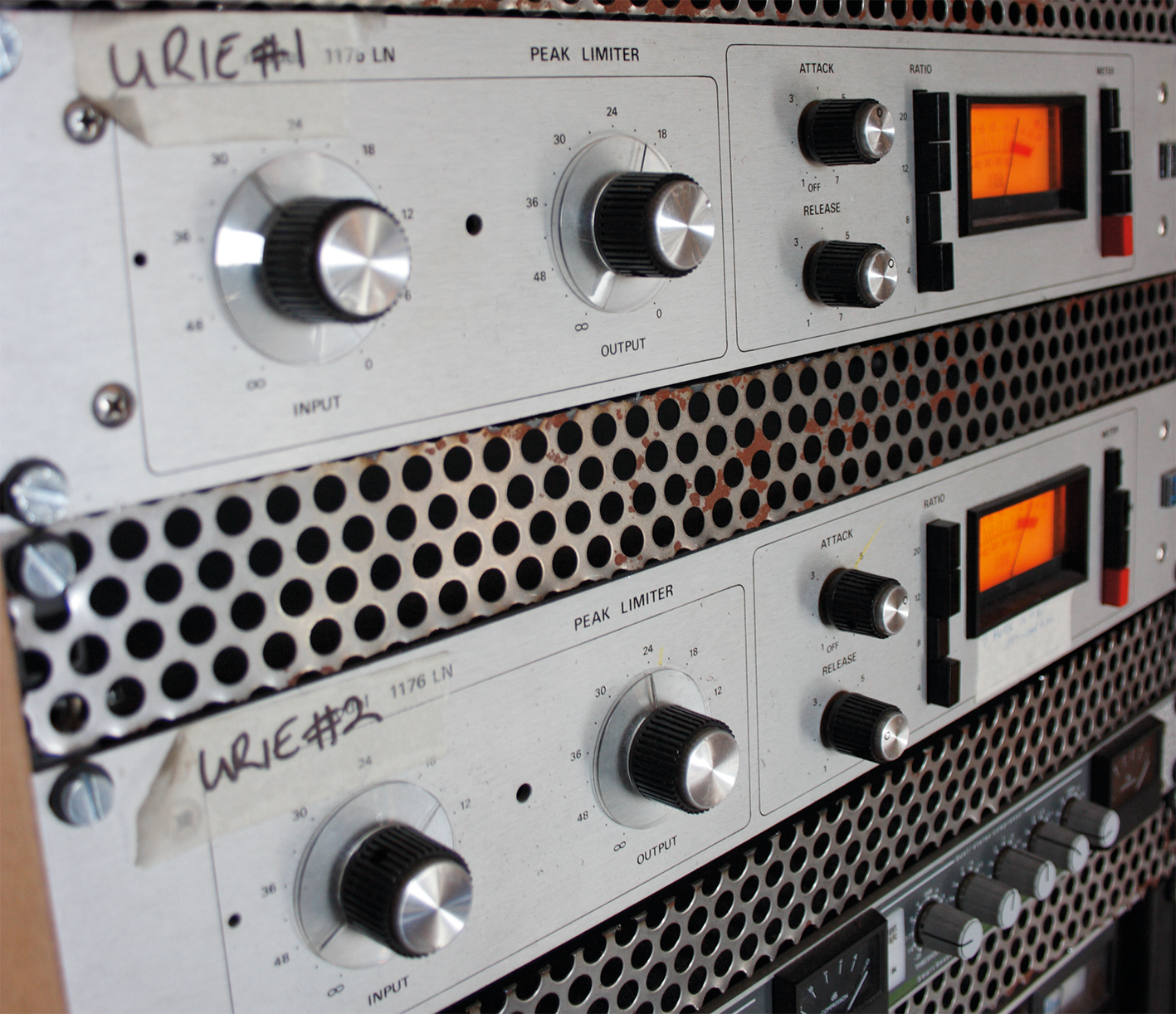
Software compressors vs hardware compressors... 10 of the best
With its high quality signal-path and competitive price-point, the 160 VU became a viable alternative for studios attempting to keep up with the ever-expanding number of tracks available in the early and mid-1970s (keep in mind that engineers might need a compressor for every channel on their mixer, and as multi-track recording formats and mixers grew in size, so to did the demand for evermore rack-mounted compressors - things could easily get very expensive, and high-quality, cost-effective options were a must!).
Whilst the 160 VU had a fairly fixed characteristic due to the lack of control over ratio, attack and release, its ubiquitous nature meant that it became part of a particular sound that people wanted on their recordings. Although arguably simpler than some of its rivals it’s nonetheless highly desirable, and if you’re looking for some vintage characteristics, especially on your drums or rock vocals, give this compression model a try.
Vintage VCA
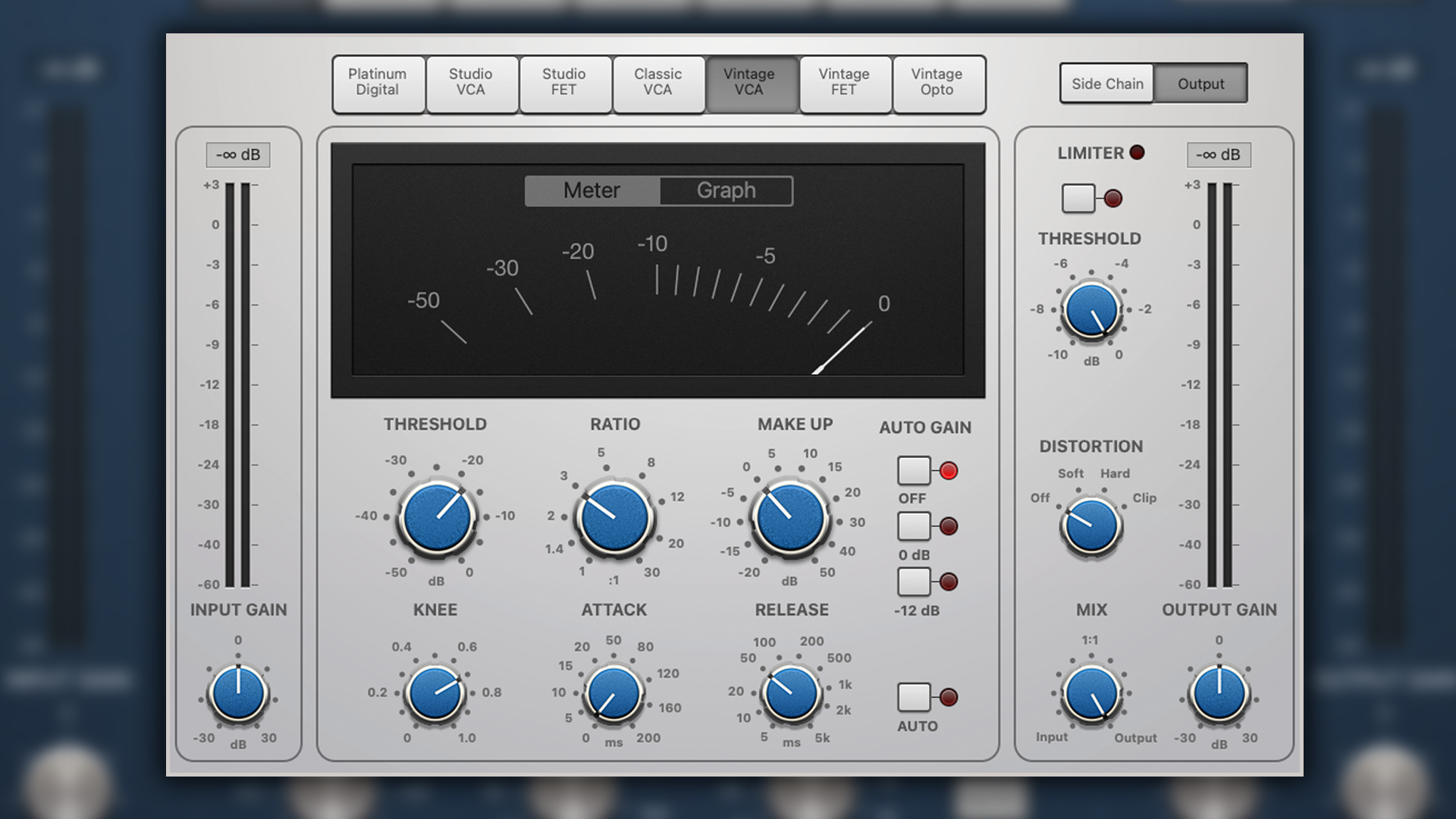
This model is based on a compressor that was an integrated part of a mixing console (and a very iconic mixing console at that); the Solid State Logic SL4000. Developed in the 1970s the SL4000 was the favoured desk of many well-known producers and was the board on which many iconic records were cut.
This was the first console that incorporated compression on every channel and every bus, making it a highly versatile desk, less reliant on outboard, rack-mounted equipment and allowing for a faster workflow.

Naturally, as it was so widely used, its compressor (and EQ) has been coveted and recreated in various guises ever since, both physically and virtually (in software format). Logic’s take on this compressor retains a variable dial ratio (as opposed to switching), and also uses a variable attack (as opposed to fast/slow switching), but otherwise stays faithful to the sonic characteristic of the compressor on which it’s modelled.
This model is this writer's personal compressor of choice for most applications, and I’ve used it for several years now (over 3rd-party options). The way it handles low-end swell is very much to my liking. I also find it to have an open airiness that suits my approach. It can smooth and soften, without noticeably removing the body of the signal (probably that SSL silkiness).
It’s also still capable of very precise and detailed compression if need be, without getting overly pulsed or pumping; a nice balance between modern capabilities and that late 1970s character that was arguably the peak of analogue recording.
Vintage FET

Here we’re back in the territory of the previously mentioned 1176. Whilst the 1176 model outlined above is based on later iterations of this iconic compressor, this model is based on the earliest iteration of the circuit’s design, dating back to 1967. The primary differences being in the resistor values, yielding a subtly different tonal and dynamic characteristic.
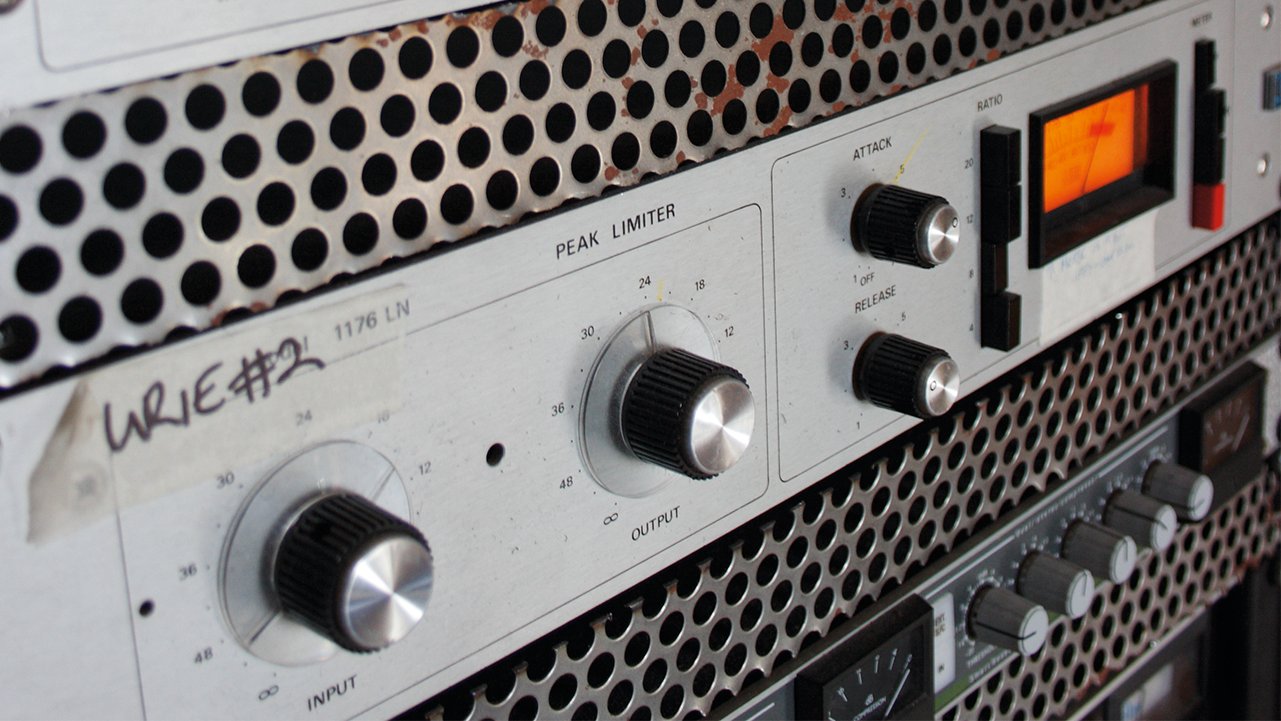
In my opinion, there’s not a huge amount to pick between them (although the vintage version includes a variable knee, whereas the studio version has a fixed knee), however, if you A/B them on the same audio source (for example, a drum bus), you’ll likely find the vintage version to be a little more colourful and pronounced in the 2-5KHz range of the frequency spectrum, giving things like the hi-hats and snare a little more crackle and bite (most likely due to it not reacting as intensely to those frequencies).
It’s hard to make concrete recommendations with this model (versus the Studio FET), and so I’d recommend simply trying them both and opting for the one you prefer the most.
Vintage Opto
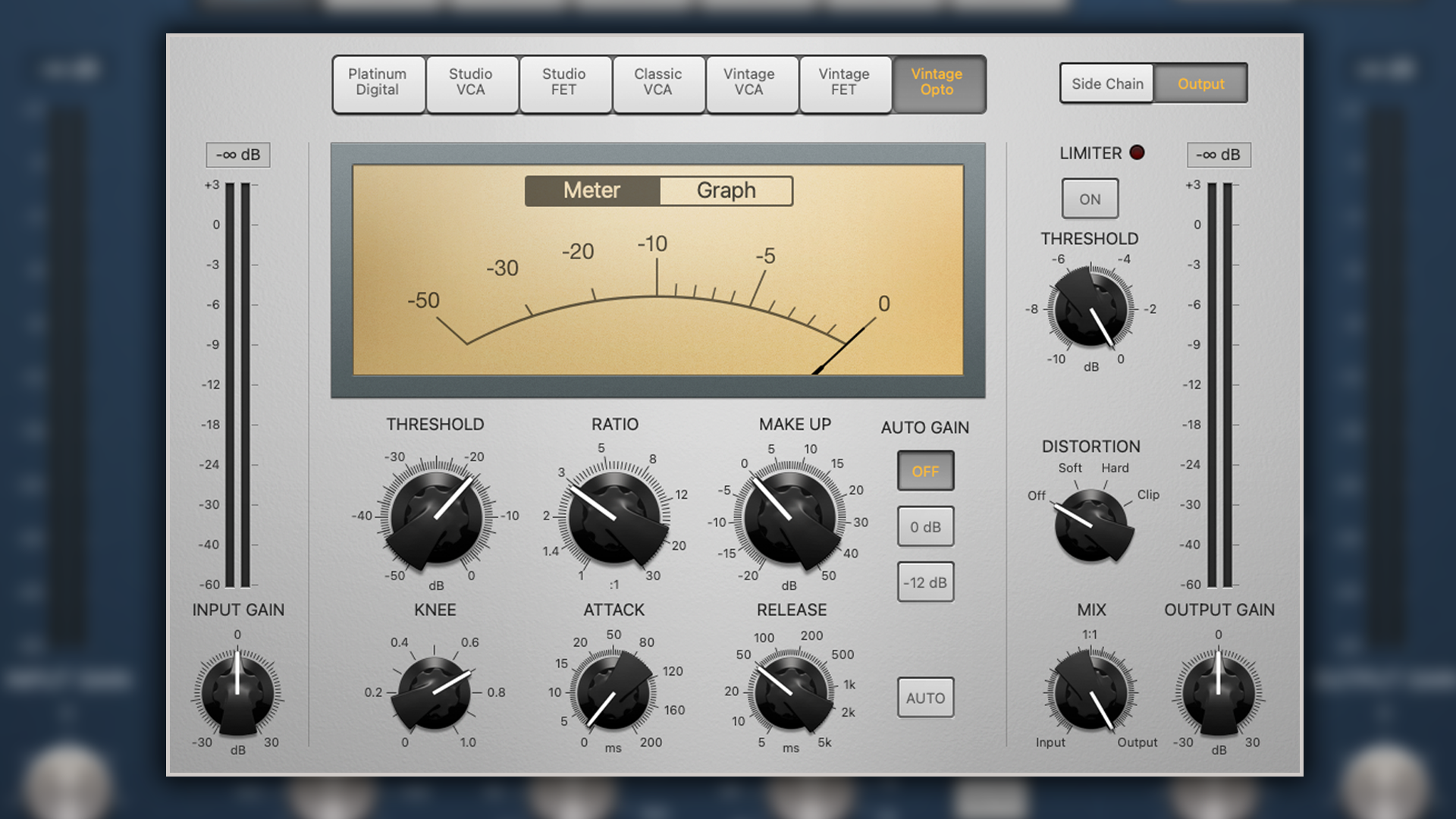
Lastly, we have a model based on one of the most iconic compressors of all, the Teletronix LA-2A. An optical compressor from 1965, this unit can be found on more hits than you can shake a stick at, and was even inducted into the TECnology Hall of Fame in 2004.
A vacuum-tube compressor, the LA-2A is distinctly colourful, characterful and warm. Regardless of what you’re applying it to, you can likely find testimonials online, from engineers and producers waxing lyrical about just how good and suitable it is for a range of applications. From kick-drums to vocals, the LA-2A garners praise from some of the biggest names in the industry.
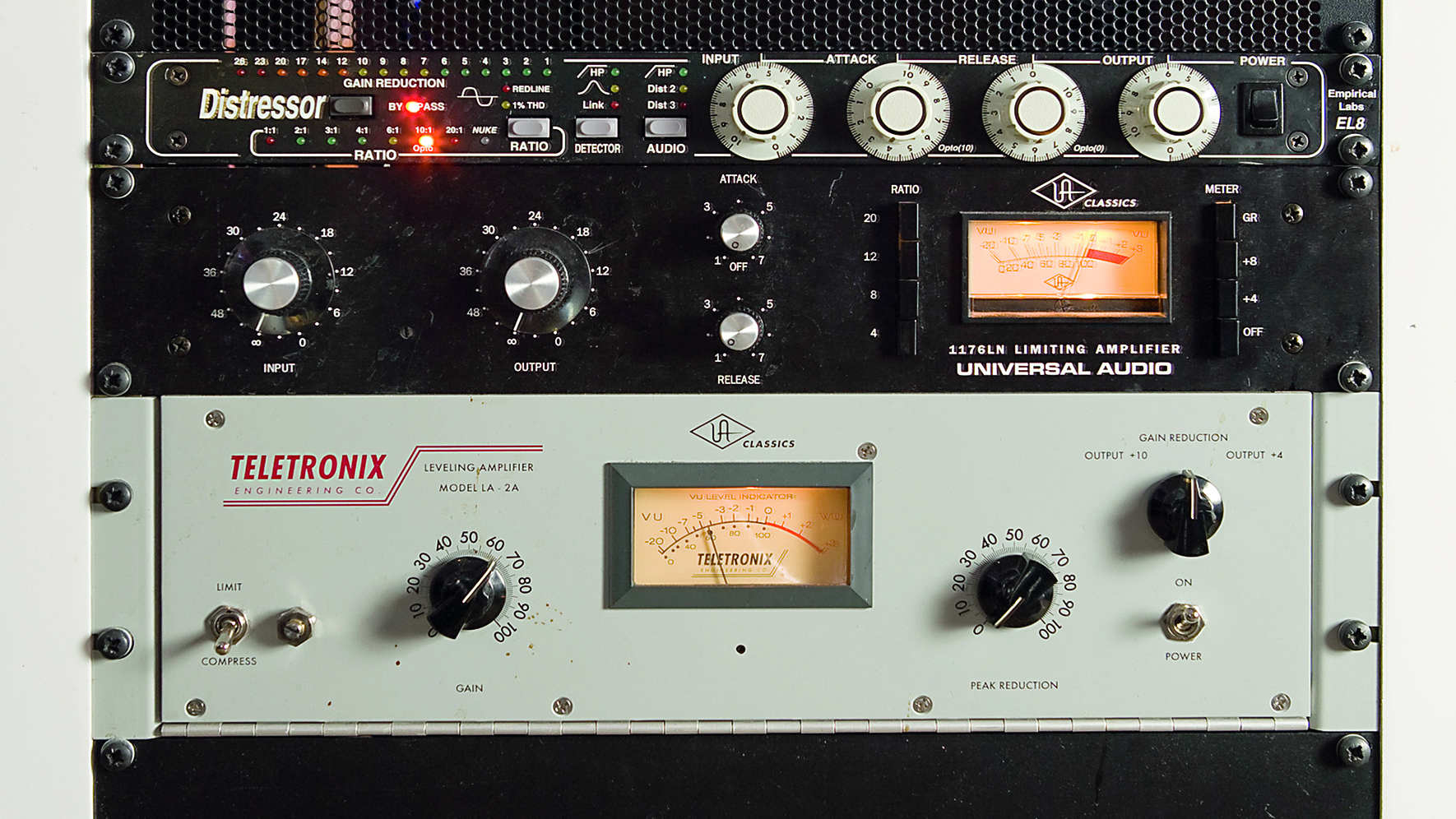
Whereas the original was a fairly bare-bones unit, with just gain and peak reduction controls, Logic’s version maintains ranged dials for all parameters, far exceeding the control parameters of the original hardware unit. This means you can shape and sculpt your compression with as much detail as you need, whilst retaining the character and warmth of analogue, vacuum-tube emulation.
I often find myself using this on buses and/or the master bus, just knocking a decibel or two off the spikiest peaks for a little added colour and attenuation.
Spoilt for choice...
With all that covered, it’s fair to say that us Logic users are a little spoilt for choice. It’s always struck me a little odd that Logic doesn’t make a bigger deal about these compression models in its marketing and so on.
I’ll admit that I was late to the game on this matter, having spent considerable money in the past on several 3rd party compressors, none of which I use anymore. These days I find myself only reaching for Logic’s stock compressor, and rarely, if ever, find myself wanting more from a compressor than Logic is able to offer.

Now add to all of the above:
- It’s a stock plugin (no additional costs)
- CPU load and latency is almost non-existent
- Supports mono, stereo, and dual-mono modes
- Input/output gain control
- Input/output level-meters
- Has two large and well designed compression-metering options
- It’s gain-reduction metering is integrated into Logic Pro’s channel-strip
- It has a built-in limiter
- It has full side-chain support (including features such as peak/RMS analysis and filtering)
Frankly, there is so much variety in this compressor that I’m hard-pressed to think of any meaningful shortcomings.
So, before you go spending lots of money on an SSL, DBX, Focusrite, 1176 or LA-2A emulation plugin, I strongly recommend you spend a day with Logic’s compressor models, familiarising yourself with their characteristics.
Remember, their differences are unlikely to be starkly obvious at first, as compression can be a game of nuance and subtlety that takes a while to tune into, but once you know what you’re listening out for, you might be pleasantly surprised at just how much Logic’s stock compressor punches above its weight.


“OSC” Steve is a composer, producer and educator with a background in piano, synthesisers and sound-engineering. He is an established, independent artist in the Synthwave and Retrowave music scenes, and has composed for several independent video-games including Nintendo Switch™ titles.
